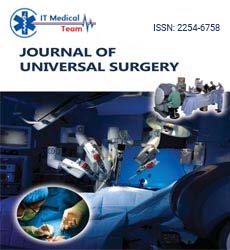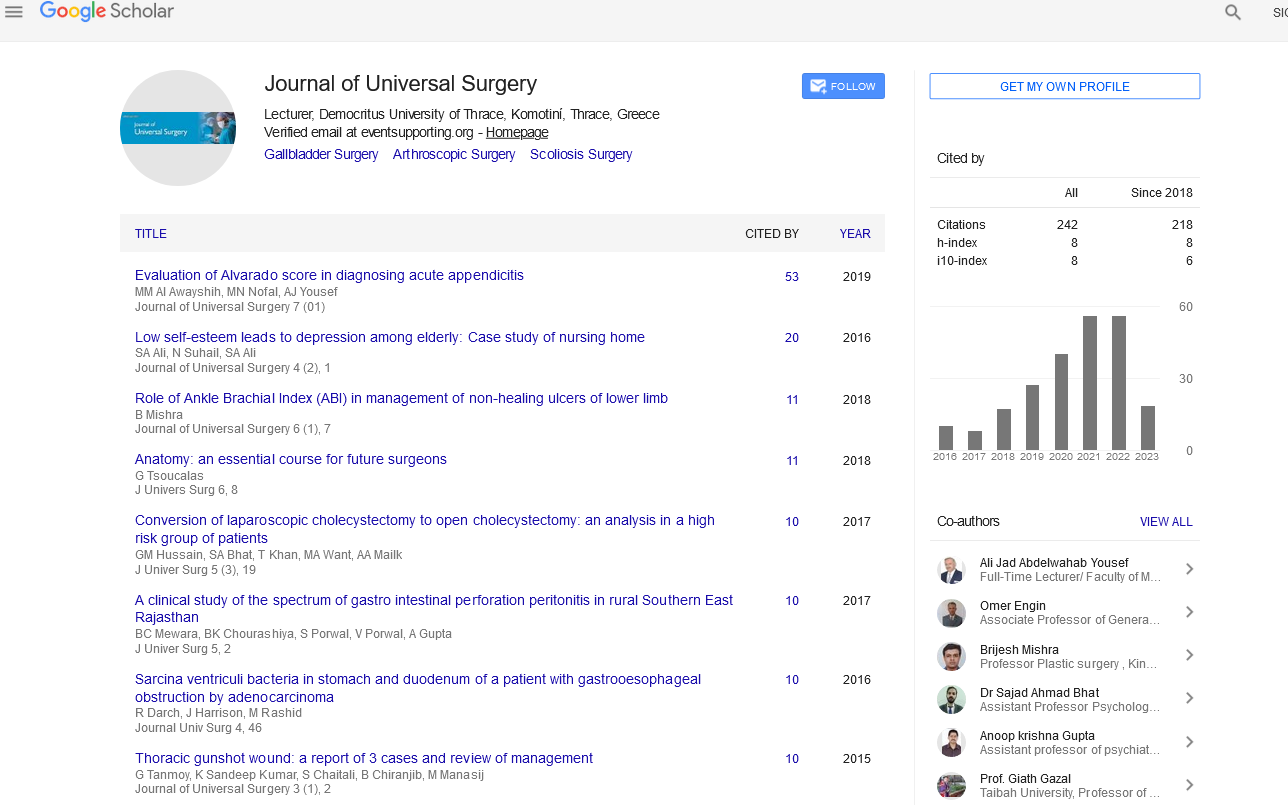Mini Review - (2023) Volume 11, Issue 4
Does Body Mass Index Important in Preoperative Evaluation of Patients Electing Gastrointestinal Surgery?
Michele Carron*
Department of Medicine, Anesthesiology and Intensive Care, University of Padova, Via C. Battisti 267, 35121 Padova, Italy
*Correspondence:
Michele Carron, Department of Medicine, Anesthesiology and Intensive Care, University of Padova, Via C. Battisti 267, 35121 Padova,
Italy,
Email:
Received: 03-Apr-2023, Manuscript No. IPJUS-23-13579;
Editor assigned: 05-Apr-2023, Pre QC No. P-13579;
Reviewed: 19-Apr-2023, QC No. Q-13579;
Revised: 21-Apr-2023, Manuscript No. R-13579;
Published:
28-Apr-2023
Abstract
At Queen Elizabeth Hospital in Birmingham (QEHB), there is no specific
procedure for stratifying patients by body mass index (BMI). This study
aimed to evaluate the outcome after gastrointestinal surgery. Patients
undergoing gastrointestinal surgery who attended the Pre-Assessment
Screening (PAS) clinic from August to September 2016 at QEHB were
identified. The primary outcome was postoperative complications.
Secondary outcomes were major complications and 30-day readmission
rates. Result. Of the 368 pre-evaluated patients, 31% (116/368) were
overweight and 35% (130/368) were obese. Median age was 57 years
(range: 17-93). There was no difference in BMI between low-risk and
high-risk clinics. Patients in high-risk clinics have significantly higher
morbidity, major surgical grade, and malignancy as an indication for
surgery. The overall complication rate was 14% (52/368), of which
3% (10/368) had serious complications (Clavien-Dindo Grade III-IV).
Although BMI was associated with comorbidities and ASA level, it was
not associated with worse outcomes. Patients presenting to a highrisk
clinic have a significantly higher rate of complications. Findings
the degree of surgery is considered an independent risk factor for
complication rates. It is not reasonable to use BMI as an independent
factor for the extent of prior assessment in our cohort. The prevalence
of obesity is rapidly increasing in developed countries, with prevalence
rates in the US (35.7%) and the UK (26.1%) expected to double.
Estimates predict that up to 66% of patients undergoing surgery in the
UK are overweight. Current conflicting evidence regarding the impact
of obesity on postoperative complications following major surgery.
Multicenter studies of specific patient populations in Japan, Denmark,
Switzerland, and the United States have associated obesity with worse
or neutral short-term postoperative outcomes.
Keywords
Body mass index; rectal neoplasms; Pelvic exenteration;
Treatment outcome
INTRODUCTION
Despite this, there is little evidence for the benefit of
preoperative management of obese patients in specialized
high-risk pre-assessment clinics and its impact on
postoperative outcomes [1]. Such as complications
and length of hospital stay [2]. The recently published
guidelines of the Association of Anesthesiologists of Great
Britain and Ireland (AAGBI) recommend that all obese
patients be assessed preoperatively by an anaesthesiologist
in clinics [3]. However, clinical evidence to support this
recommendation is lacking and is largely based on expert
opinion [4]. Since the variable of interest is body mass
index (BMI), randomized trials that refer patients to preassessment
clinics cannot be performed [5]. To build on the
limited literature and provide more insight into the need for
pre-assessment stratification by BMI, this prospective study
seeks to assess the impact of BMI on Postoperative outcomes
in patients undergoing preoperative gastrointestinal
evaluation. This prospective study identified patients who
attended the Pre-Assessment Screening (PAS) clinic for
minor to major gastrointestinal surgery between August
2016 and September 2016 at Queen Elizabeth Hospital,
Birmingham (QEHB) [6]. Adult patients (≥18 years) with
persistent BMI > 30 kg/m2 undergoing gastrointestinal
or hepatobiliary surgery were included in the study [7].
Eligible procedures are those that involve surgery on any
part of the gastrointestinal tract or biliary tract, involving
an overnight hospital stay. Patients undergoing urological,
gynecological, vascular, or transplant procedures on an
outpatient basis were excluded [8]. This study was recorded
and approved by the local audit department [9]. The
patient's medical records were reviewed and data extracted
into a unified database (Microsoft® Excel 2010) designed
to include all details relevant to this study. At QEHB, all
patients undergoing surgery are referred by the surgeon to
specialized pre-assessment clinics based on the extent of
surgery and comorbidities [10]. Clinics are divided into
low-risk and high-risk clinics; numerically, they correspond
to levels 1 and 2A and 2B and 3, respectively. Low-risk
clinics are led and conducted by nurses trained in preassessment,
while high-risk clinics are led and performed
by private nurses and Anesthesiologists.
DISCUSSION
The primary explanatory variable was preoperative BMI,
assessed during attendance at the PAS clinic. BMI is
calculated as weight (in kilograms) divided by the square
of height (in meters). With the primary objective of this study to assess the effects of overweight or obesity, patients
were stratified by BMI into groups defined by the World
Health Organization (WHO) as: normal weight (BMI
18) ,5–24.9 kg/m2), overweight (BMI 25.0–29.9 kg/m2)
and obese (BMI ≥ 30.0 kg/m2). The explanatory variables
were collected to provide risk-adjusted estimates. Variables
were predefined and selected based on clinical plausibility.
Comorbidities were assessed using the American
Association of Anesthesiologists (ASA) Physical Score
Scale, a standard measure of disease severity and a reliable
method for assessment. Mortality and complications
after surgery surgical grade is a category that indicates the
combination of complexity and extent of tissue damage
in the surgical procedure. The exact definitions used are
similar to those in a recent publication of the European
Surgical Outcomes Study [10]. Surgical method was
defined as open, laparoscopic or laparoscopic/ultrasound
(applicable to minor surgery only.
CONCLUSION
The primary endpoint was complications after 30 days
as defined by the Clavien-Dindo classification system.
Secondary outcomes were major complications, 30-day rehospitalization
rates, and postoperative care environment.
This study was designed to detect minimally significant
differences between normal weight, overweight and obese
patients. A minimum of 356 patients is required to provide
80% energy α = 0.05. The baseline characteristics were
compared between groups using Pearson's chi-square
test for categorical variables and Mann-Whitney test for
continuous variables. Multivariable logistic regression was
used to determine the association between risk factors for
postoperative complications. Models constructed included
age, sex, and ethnicity, and surgical grade, presence of
specific comorbid conditions, surgical specialty, and
surgical approach. The results are presented as a risk ratio
RR with a 95% confidence interval. In all analyses, a
value <0.05 was maintained as statistically significant. All
data analyses were performed using IBM SPSS Statistics
Version 22.0. More experienced consultant. As there was
no systematic risk stratification method, each patient was
assigned a PAS clinic based on the referring surgeon's
preliminary individual risk assessment.
REFERENCES
- Large Intestine In Gray's Anatomy: The Anatomical Basis of Clinical Practice. AJNR Am J Neuroradiol. 2008; 26: 2703-2704.
Google Scholar, Crossref
- Rociu E, Stoker J, Eijkemans MJ, et al. Normal anal sphincter anatomy and age- and sexrelated Variations at high-spatial-resolution endoanal MR imaging. Radiology. 2000; 217: 395.
Google Scholar, Crossref, Indexed at
- Sahni VA, Burling D. Imaging of anorectal fistula. Semin Colon Rectal Surg. 2009; 20: 2.
Google Scholar, Crossref
- Garcia Aguilar J, Belmonte C, Wong WD, et al. Anal fistula surgery. Factors associated with recurrence and incontinence. Dis Colon Rectum. 1996; 39: 723.
Google Scholar, Crossref, Indexed at
- Włodarczyk M, Włodarczyk J, Sobolewska Włodarczyk A, et al. Current Concepts in the pathogenesis of cryptoglandular perianal fistula. J Int Med Res. 2021; 49: 300060520986669.
Google Scholar, Crossref, Indexed at
- Abramowitz L, Soudan D, Souffran M, et al. the outcome of fistulotomy for anal fistula at 1 year: a prospective multicentre French study. Colorectal Dis. 2016; 18: 279.
Google Scholar, Crossref, Indexed at
- Rizzo JA, Naig AL, Johnson EK et al. Anorectal abscess and fistula-in-ano: evidence-based management. Surg Clin North Am. 2010; 90: 45.
Google Scholar, Crossref, Indexed at
- Holzheimer RG, Siebeck M. Treatment procedures for anal fistulous cryptoglandular abscess--how to get the best results. Eur J Med Res. 2006; 11: 501.
Google Scholar, Indexed at
- Shanwani A, Nor AM, Amri N, et al. Ligation of the intersphincteric fistula tract (LIFT): a sphinctersaving technique for fistula-in-ano. Dis Colon Rectum. 2010; 53:39.
Google Scholar, Crossref, Indexed at
- Whiteford MH, Kilkenny J, Hyman N, et al. Practice parameters for the treatment of perianal abscess and fistula-in-ano (revised). Dis Colon Rectum. 2005; 48: 1337.
Google Scholar, Crossref, Indexed at





